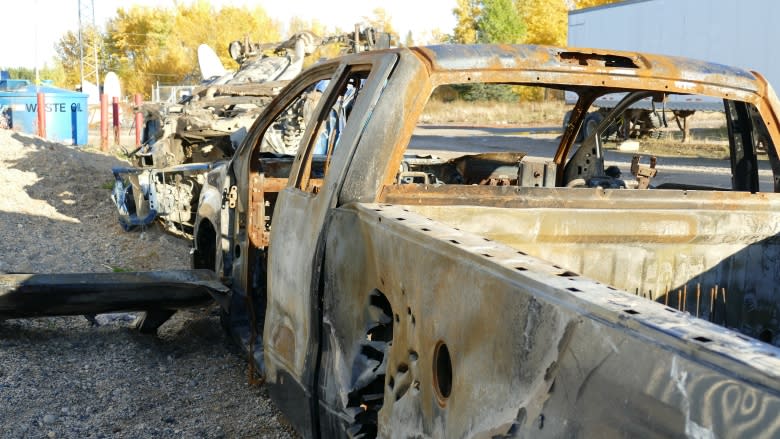'We just watched it burn': Shamattawa can't fight blazes without working fire truck, chief says
If a fire breaks out in Shamattawa First Nation, community members and leaders say there is little they can do but watch it burn.
The isolated northern Manitoba First Nation, 745 kilometres northeast of Winnipeg, has been repeatedly ravaged by arsons but has had no operational fire truck or hall since September.
"It's very, very concerning," Chief Jeffrey Napaokesik told CBC News. "Recently we had a house that was not occupied, it was boarded up and someone lit a fire inside and … we just couldn't do anything. We just watched it burn."
Napaokesik said the fly-in community's sole fire truck is in need of extensive repairs and has to be transported to Winnipeg to be fixed. However, the truck can't be transported until the new year, after the winter road is constructed, he said.
In the meantime, Napaokesik said it's "almost impossible" to respond to a major fire.
"The only thing to do right now is to try and equip ourselves with portable fire extinguishers to try and respond to fires," he said, adding they have a local water truck with a jet nozzle and can rely on fire hydrants — if they're nearby.
"It's scary" for community members, he says, because the First Nation has endured several devastating fires and arsons in recent years.
In September 2016, Shamattawa declared a state of emergency after its band office and only grocery store burned to the ground in a fire — allegedly set by kids. At the time, the fire truck had broken down and was not able to respond.
That same year, the First Nation lost a series of teaching units to arson, believed to be set by youth.
This spring, flames tore through a warehouse containing building supplies for six housing units.
Then in late November, a housing unit for a teacher was deliberately torched. Someone found maintenance keys, entered the locked unit and set fire to a mattress and sofa seat, the chief said. Fire extinguishers were used to fight the flames.
Victoria Redhead lost her home and all of her possessions to arson in June 2016. She was out of town at the time and was told the fire was deliberately set by youth — but no one was caught or charged.
She said it's frightening to know her community isn't properly equipped to respond in an emergency.
"I would like to see my leaders work on this situation — at least get some fire extinguishers for each household," she said, adding her new home isn't equipped with one.
"I don't want to see another person's house burn the way my house burnt."
Fire protection essential service: feds
In an email, a spokesperson for Indigenous Services Canada said "departmental officials are working with the First Nation to explore interim fire protection solutions."
The statement said chief and council informed the department the truck is out of operation and a mechanic indicated it will have to be sent out of the community for repairs.
Indigenous Services said it funded a new fire truck for Shamattawa in 2015 and the community receives $53,000 in annual funding for fire protection services, which includes maintenance of the fire truck.
"Fire protection is an essential service that can make a difference between life and death," the statement read.
"This is why the Government of Canada is committed to making significant investments in infrastructure and to work in partnership with provinces, territories, municipalities and First Nation communities to address issues such as fire protection on reserve."
Inadequate fire protection: MKO grand chief
Shamattawa is not the only First Nation underprepared in terms of fire protection and in Manitoba, the consequences have been deadly.
In 2011, two-month-old Errabella Harper died in a house fire in the Manitoba community of St. Theresa Point. At the time, the First Nation's fire truck was broken.
Weeks later, Daphne Benjoe was killed in a house fire on Roseau River First Nation. Firefighters were unable to douse the blaze because fire hydrants had frozen due to lack of maintenance.
In the months following, Demus James and his two grandchildren died in a house fire in Gods Lake Narrows First Nation. Neighbours reportedly tried to extinguish the fire with buckets of water, wet towels and a low-pressure hose.
A 2012 report by the Manitoba Office of the Fire Commissioner and the Assembly of Manitoba Chiefs, which surveyed 62 First Nations, found 15 per cent said they had enough hose to respond to a fire, a third did not have a fire truck and 39 per cent had no fire hall.
Manitoba Keewatinowi Okimakanak Grand Chief Sheila North Wilson said inadequate fire protection is still a problem on Manitoba First Nations and more needs to be done to protect these communities.
"We need to see more resources afforded to them so they can maintain the level of services that will keep all of their citizens safe."
North Wilson said Shamattawa is "one of the worst" in terms of available supplies and resources to maintain the community because of its remoteness. She said there need to be "real commitments" when it comes to fire protection, education and housing.
"The people of Shamattawa deserve better than that," she said. "We're hearing a lot of stress and concerns from our youth there. If the adults and their parents are stressed, then the children feel it too."



